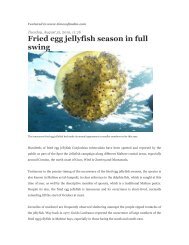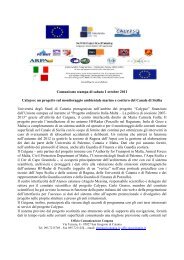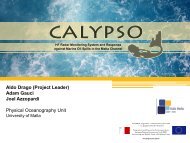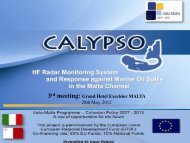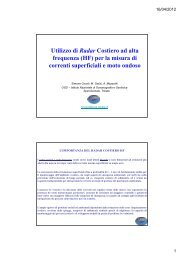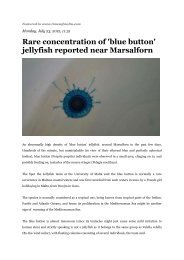Interview with Dr. Alan Deidun - University of Malta
Interview with Dr. Alan Deidun - University of Malta
Interview with Dr. Alan Deidun - University of Malta
You also want an ePaper? Increase the reach of your titles
YUMPU automatically turns print PDFs into web optimized ePapers that Google loves.
Featured in www.independent.com.mt<br />
<strong>Interview</strong>: Jellyfish bloom expected in August<br />
Keith Micallef<br />
16 April 2012<br />
Though it is only April, reports <strong>of</strong> jellyfish sightings around the Maltese Islands have already<br />
made the news. Keith Micallef recently met <strong>with</strong> marine biologist and founder <strong>of</strong> the Spot The<br />
Jellyfish Campaign <strong>Alan</strong> <strong>Deidun</strong> about the subject. According to him, though jellyfish blooms<br />
are still highly unpredictable, evidence suggests that next summer swimmers are likely to<br />
encounter jellyfish towards August and not by late May as is the norm.<br />
According to marine biologist <strong>Alan</strong> <strong>Deidun</strong>, any jellyfish blooms likely to appear next summer<br />
will come around later than usual. He is also expecting new species <strong>of</strong> tropical jellyfish to reach<br />
our shores. At the beginning <strong>of</strong> the interview <strong>Dr</strong> <strong>Deidun</strong> distanced himself immediately from<br />
any foolpro<strong>of</strong> predictions and stated that in this field one can only dare an educated guess. He<br />
claims that evidence this year so far suggests that adult jellyfish came to the surface to<br />
reproduce in warmer waters much later than usual. While normally this process takes place in<br />
December and January, this year this happened towards the end <strong>of</strong> February. Incidentally this<br />
is the reason for such huge numbers <strong>of</strong> dead jellyfish which are usually reported in winter.<br />
As a result mauve stingers (the common pink jellyfish) this year may appear later than usual,<br />
maybe in August, whereas normally they start to appear in May or June. However this is just a<br />
guess, as this is a highly unpredictable subject. The fact that last year was a jellyfish-free<br />
summer is a clear example. <strong>Dr</strong> <strong>Deidun</strong> also predicted that new tropical species may be recorded<br />
this summer.<br />
“This is due to the fact that in neighbouring countries new species have been reported. The
Australian Spotted Jellyfish in Italy and the Compass Jellyfish in Spain are two examples. As a<br />
pre-emptive strategy, we place such species on our educational leaflets.” Asked about any<br />
particular chronological patterns in jellyfish blooms, <strong>Dr</strong> <strong>Deidun</strong> explained that from records<br />
dating back 150 years, it is being observed that in recent years peaks have been more frequent<br />
and pronounced. However large masses <strong>of</strong> mauve stingers have been observed for decades and<br />
in the eighties local water polo games had to be cancelled and teams had to go and train<br />
abroad. He recalled that back in the late fifties an advert <strong>of</strong> a jellyfish repellent cream was<br />
published in a local newspaper.<br />
Economical, social and ecological disruption<br />
In the ecological chain, the role <strong>of</strong> jellyfish is to act as scavengers and so serve as a natural<br />
means to eliminate the weakest organisms. Another function is to filtrate water from plankton.<br />
The main problems arise when jellyfish appear in huge numbers all <strong>of</strong> a sudden. The Canary<br />
Islands right now are experiencing a bloom <strong>of</strong> apocalyptic proportions and mauve stingers are<br />
literally being bulldozed from the beaches. In the last 28 days 3.25 tonnes <strong>of</strong> jellyfish were<br />
removed from a single beach. <strong>Dr</strong> <strong>Deidun</strong> cited the positive impact that jellyfish may be having<br />
on the diving industry. He floated the idea that authorities need to seriously consider<br />
promoting a new niche <strong>of</strong> jellyfish tourism, also in view <strong>of</strong> the fact that overfishing is<br />
threatening the already fish depleted seas around <strong>Malta</strong>. Regarding the ecological benefits or<br />
threats that jellyfish pose in general he said that huge outbreaks <strong>of</strong> jellyfish are having a<br />
negative impact on the overall population <strong>of</strong> fish as they are consuming large amounts <strong>of</strong><br />
plankton and other foods on which the fish depend. The traditional kinds <strong>of</strong> jellyfish use their<br />
stingy tentacles full <strong>of</strong> capsules to squirt their venom to catch their prey. Other kinds <strong>of</strong> jellyfish<br />
called comb jellies which are not stingy have sticky tentacles, which have the same purpose.<br />
The latter are becoming more popular <strong>with</strong> divers as these may be handled freely <strong>with</strong>out any<br />
risks. Another form <strong>of</strong> jellyfish that fishermen are familiar <strong>with</strong> are called salps, which<br />
resemble long chains <strong>of</strong> jellyfish which may stretch several kilometres.<br />
“As a marine biologist I am focusing more on the threats especially those caused by stinging<br />
jellyfish and the blooming population which causes an ecological imbalance. In some cases<br />
jellyfish are producing so much mucus, which is a gelatinous substance, that parts <strong>of</strong> the sea<br />
are becoming toxic and consequently impacting negatively on marine life. The best term that
can describe the overall impact on marine life that jellyfish are causing is disruption,” said <strong>Dr</strong><br />
<strong>Deidun</strong>.<br />
The effects <strong>of</strong> alien species entering the Mediterranean<br />
<strong>Malta</strong>‟s position in the centre <strong>of</strong> the Mediterranean is a crucial factor when it comes to new<br />
species reaching our shores. The main reason is that new species entering the Mediterranean<br />
from the Straits <strong>of</strong> Gibraltar or from the Red Sea, will find it very hard to make it to the centre<br />
due to various factors, mainly the distance and the sea temperature. Last year the local<br />
scientific community was shocked when evidence <strong>of</strong> the presence <strong>of</strong> nomadic jellyfish in<br />
Maltese waters was published by <strong>Dr</strong> <strong>Deidun</strong>. This kind <strong>of</strong> jellyfish can reach huge proportions<br />
<strong>of</strong> about half a metre in diameter and made its way from the Red Sea in the late eighties and<br />
early nineties.<br />
In Eastern Mediterranean countries like Israel this has become a national issue causing power<br />
cuts due to large numbers <strong>of</strong> nomadic jellyfish blocking the cooling systems <strong>of</strong> the power<br />
station. In other countries like Lebanon and Turkey, it is resulting in financial losses for<br />
fishermen who have to discard their nets once they become blocked <strong>with</strong> this species <strong>of</strong><br />
jellyfish. On one particular occasion in Israel a line stretching about 50 kilometres and two<br />
kilometres wide was reported, which is equivalent to 100 square kilometres <strong>of</strong> nomadic<br />
jellyfish. This huge mass devoured large amounts <strong>of</strong> plankton to sustain itself thus stressing<br />
even more the already scarce food supply for marine life in the region. Other impacts were the<br />
closure <strong>of</strong> long stretches <strong>of</strong> beaches as this kind <strong>of</strong> jellyfish is a painful stinger like the<br />
Portuguese Man <strong>of</strong> War, which as the name suggests is also an alien species to the<br />
Mediterranean as it comes from the Atlantic.<br />
New species reported in <strong>Malta</strong> so far<br />
Prior to last year it was believed that the furthest place that nomadic jellyfish were recorded<br />
was Greece. “However last year I came across some footage dating back to 2004, which clearly<br />
shows this alien species in Maltese waters. Fortunately since then no further reports have<br />
surfaced and this could indicate that no mating has taken place here. This phenomenon is<br />
called Leseppsianism after the French engineer, Ferdinand de Lesepps who designed the Suez
Canal in the nineteenth century. More recently this year we are witnessing crystal jellyfish<br />
which is innocuous to humans. Since the launch <strong>of</strong> the Spot the Jellyfish campaign in 2010<br />
about eight species have been recorded in <strong>Malta</strong> for the first time, some <strong>of</strong> which were present<br />
before but were never scientifically reported. “One particular case was that <strong>of</strong> a French student,<br />
who was only 12 years old and discovered a new species, called the blue button in Dwejra, while<br />
she was on holiday. Previously it was believed that this species thrived in tropical waters.”<br />
Another recent discovery was the „upside down jellyfish‟ which as the name suggests lives on<br />
the seabed in an inverted position <strong>with</strong> its tentacles stretching up. Just like plants this species<br />
needs sunlight to grow and its tentacles serve that purpose as they stretch towards light. The<br />
phenomenon <strong>of</strong> Leseppsianism is also common in fish and crustaceans.<br />
It is estimated that two thirds <strong>of</strong> alien species come from the Red Sea and the rest from the<br />
Atlantic Ocean. The African Moonfish is a species recorded in <strong>Malta</strong> which is very common in<br />
the tropical water <strong>of</strong> Equatorial Guinea. The factor that may be tilting the balance towards the<br />
east is the tropicalisation <strong>of</strong> the Mediterranean. Therefore alien species from the Red Sea may<br />
be more adaptable to warm waters than those from the Atlantic. In <strong>Malta</strong> we get some species<br />
from both extremes though species from the East very rarely reach our shores. Several<br />
exceptions are the cornet fish and the rabbit fish which are even ending up in the local fish<br />
markets, such as that in Marsaxlokk.<br />
Causes <strong>of</strong> jellyfish blooms<br />
Replying to popular belief that pollution may be one <strong>of</strong> the causes for the increase in the<br />
number <strong>of</strong> blooms, <strong>Dr</strong> <strong>Deidun</strong> said that this is a million dollar question. Among the most<br />
important factors overfishing is one <strong>of</strong> the causes, <strong>with</strong> fish being replaced by jellyfish.<br />
Secondly the increase in sea temperature is greatly influencing the life cycle <strong>of</strong> the jellyfish<br />
which is being accelerated and also causing certain species such as the mauve stinger to survive<br />
in winter.<br />
“In fact this year we are witnessing abnormally large mauve stingers <strong>of</strong> up to 15 cm diameter<br />
which may be due to the fact that they manage to survive winter. As regards pollution –<br />
specifically the use <strong>of</strong> fertiliser in agriculture, which is washed down to sea – this also<br />
stimulates the growth <strong>of</strong> some species. The fourth reason is thought to be the increase <strong>of</strong>
artificial surfaces, as jellyfish prefer to lay their eggs on flat surfaces like jetties, pontoons,<br />
terminals and wharves. “Contrary to popular belief, the decrease in population <strong>of</strong> sea turtles<br />
which feed on jellyfish, is also having an impact, however this is thought to be a marginal one<br />
and not a major one as some are claiming.”<br />
One <strong>of</strong> the most feared kinds is the box jellyfish which in some parts <strong>of</strong> the world like Australia<br />
is lethal. <strong>Dr</strong> <strong>Deidun</strong> points to the existence <strong>of</strong> tens <strong>of</strong> thousands <strong>of</strong> this kind <strong>of</strong> species and says<br />
that none <strong>of</strong> those in the Mediterranean are deadly. The notorious Australian species is listed<br />
as the fourth most poisonous organism in the world, and claims several lives each year. The<br />
carybdea marsupialis, which is present in <strong>Malta</strong>, gives a nasty sting but is not lethal and<br />
therefore, sweeping statements mentioning box jellyfish have to be treated <strong>with</strong> caution so as<br />
not to create unnecessary panic to swimmers.<br />
Swimmers urged to be cautious and on the lookout<br />
<strong>Dr</strong> <strong>Deidun</strong> urged caution to swimmers especially in jellyfish infested waters as these may inflict<br />
serious injuries and complications. From a medical point <strong>of</strong> view another factor that plays a<br />
major role is the hyper allergenic response <strong>of</strong> the individual as the immune system <strong>of</strong> the body<br />
reacts differently when in contact <strong>with</strong> a threat. In other words some people may be more<br />
„resilient‟ to jellyfish. “In <strong>Malta</strong> we can consider ourselves lucky as we are not exposed to the<br />
amount <strong>of</strong> alien species that swimmers in Gibraltar or Egypt come across,” said <strong>Dr</strong> <strong>Deidun</strong>.<br />
Spot the Jellyfish Campaign<br />
Asked about the Spot the Jellyfish campaign, <strong>Dr</strong> <strong>Deidun</strong> described it as a citizens‟ science<br />
initiative in which large scale scientific projects are carried out involving the public for data<br />
collection. “In <strong>Malta</strong> we started relatively late when compared to other countries. Initially the<br />
campaign was mainly targeted at children, but due to the huge feedback we got we extended<br />
the campaign nationwide. We tried to be as innovative as possible in our approach and the<br />
public can submit a report simply by sms. Other means <strong>of</strong> submitting reports include the<br />
website, which is updated in real time or by post using one <strong>of</strong> our leaflets. Another initiative is<br />
the placing <strong>of</strong> informational boards round the island‟s beaches to educate swimmers. This year<br />
we are replacing them <strong>with</strong> aluminium boards which are more weather resistant and may be
used for several years, even though they have to be removed in October. “Overall I think this<br />
campaign was a success, and we received about 800 reports in three years.”<br />
The peak season is usually in August <strong>with</strong> five or six daily reports. People can get involved by<br />
visiting www.ioikids.net/jellyfish. There is also a global campaign in Monterey Bay Aquarium<br />
in California whose website on jellywatch.org invites users from all over the world to report<br />
jellyfish sightings.<br />
The Medjellyrisk Project and other initiatives<br />
The Medjellyrisk project is a joint venture project between the <strong>University</strong> <strong>of</strong> <strong>Malta</strong> and others<br />
from Italy and Tunisia, and is currently seeking EU funds. Part <strong>of</strong> this project involves the<br />
publication <strong>of</strong> a specialised guide about treating jellyfish stings, categorised according to the<br />
species being dealt <strong>with</strong>. Other initiatives in the pipeline include local involvement in DNA<br />
research on several samples <strong>of</strong> jellyfish round the Mediterranean, which is being carried out by<br />
an Italian student <strong>of</strong> Salento <strong>University</strong> in Lecce as part <strong>of</strong> his doctorate studies. Right now <strong>Dr</strong><br />
<strong>Deidun</strong> is also gathering scientific data on the effects <strong>of</strong> fish farms on the quality <strong>of</strong> sea water.<br />
This is being carried out using satellite photography.<br />
Treating jellyfish stings<br />
The most crucial factor is determining what species one is dealing <strong>with</strong>. While some treatments<br />
may prove to be beneficial, in some cases they can make the symptoms worse. The venom <strong>of</strong> a<br />
jellyfish is composed <strong>of</strong> proteins and any substance which destroys the protein chain is deemed<br />
to be good. Acidic liquids such as vinegar, citric juice, pineapple juice and meat tenderiser in<br />
the majority <strong>of</strong> cases can be used.<br />
<strong>Dr</strong> <strong>Deidun</strong> cited that the <strong>of</strong>ficial advice from the public health is that each case has to be treated<br />
separately. Obviously the main flaw <strong>of</strong> this approach is that it is not always possible to<br />
determine the exact species <strong>of</strong> the jellyfish in question.<br />
In this case, there is still some advice to follow such as:
• Avoiding contact <strong>with</strong> fresh water as this will cause the venom capsules to spread on the<br />
affected area at a greater rate<br />
• Avoiding scrubbing the skin and if possible one should to remove parts <strong>of</strong> the tentacles using<br />
a pair <strong>of</strong> tweezers.<br />
• Do not expose the affected area to extremes in temperatures such as treating it <strong>with</strong> hot water<br />
or ice<br />
• Apply alcohol to the area<br />
• Seek immediate medical aid if having difficulties in breathing or swallowing, chest pains or<br />
intense pain in the area<br />
The emphasis must be on educating the public to recognise the jellyfish. With reference to<br />
various jellyfish creams which claim to treat stings, these are effective but only to alleviate<br />
some <strong>of</strong> the pain.<br />
Pr<strong>of</strong>ile<br />
<strong>Dr</strong>. <strong>Alan</strong> <strong>Deidun</strong> is a Senior Lecturer at the Physical Oceanography Unit <strong>of</strong> the IOI-<strong>Malta</strong><br />
Operational Centre <strong>of</strong> the <strong>University</strong> <strong>of</strong> <strong>Malta</strong>, being primarily trained and <strong>with</strong> experience as a<br />
coastal and marine biologist. He holds a PhD in biology and is recognised as a Chartered<br />
Biologist by the Institute <strong>of</strong> Biology <strong>of</strong> London.<br />
Though his earlier academic studies were in coastal biology he later shifted to marine biology.<br />
The turning point was when he decided to follow a diving course while still a university student.<br />
Once he immersed himself in the relatively unknown marine world he was eager to discover<br />
more and so decided to specialise in marine biology.<br />
He has published over 45 peer-reviewed papers in several high-pr<strong>of</strong>ile academic journals on<br />
various aspects <strong>of</strong> coastal and marine biology and has coordinated the marine ecology section<br />
<strong>of</strong> numerous recent Environmental Baseline Study (EBS), Environmental Impact Assessment
(EIA) and Appropriate Assessment (AA) studies.<br />
He has lectured biology at various levels for the past nine years and has contributed to<br />
numerous <strong>University</strong> taught and field courses. Since 2001 he has also penned hundreds <strong>of</strong><br />
popular science articles for various media portals, including newspapers, magazines and<br />
journals and is scientific advisor to a number <strong>of</strong> local environmental NGO‟s.<br />
He is also a qualified PADI-certified SCUBA diver and a keen footballer. In 2009 he ventured<br />
in the political arena, by contesting the European Parliament elections <strong>with</strong> the Nationalist<br />
Party.



